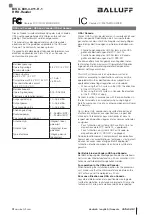
User's Guide Digiface AES
©
RME
73
As each of the 10 stereo hardware outputs can be routed to the record software, and none of
these hardware inputs get lost, TotalMix offers an overall flexibility and performance not rivalled
by any other solution.
The risk of feedbacks, a basic problem of loopback methods, is low, because the feedback can
not happen within the mixer, only when the audio software is switched into monitoring mode.
The block diagram shows how the software's input signal is played back, and fed back from the
Hardware Output to the software input.
The block diagram also shows why with activated Loopback the EQ of the Hardware Output is
now within the record path. With Loopback active the EQ of the input is not in the record path,
only in the monitoring path, even when the Option
DSP
– Record EQ
is activated.
Recording a Software's playback
In real world application, recording a software's output with another software will show the follow-
ing problem: The record software tries to open the same playback channel as the playback soft-
ware (already active), or the playback one has already opened the input channel which should be
used by the record software.
This problem can easily be solved. First make sure that all rules for proper multi-client operation
are met (not using the same record/playback channels in both programs). Then route the playback
signal via TotalMix to a hardware output in the range of the record software, and activate Loop-
back for recording.
Mixing several input signals into one record channel
In some cases it is useful to record several sources into only one track. For example when using
two microphones recording instruments and loudspeakers, TotalMix' Loopback mode saves an
external mixing desk. Simply route/mix the input signals to the same output (third row), then re-
define this output into a record channel via Loopback. This way any number of input channels
from different sources can be recorded into one single track.
26.7 MS Processing
The mid/side principle is a special positioning technique for micro-
phones, which results in a mid signal on one channel and a side
signal on the other channel. This information can be transformed
back into a stereo signal quite easily. The process sends the mon-
aural mid channel to left and right, the side channel too, but phase
inverted (180°) to the right channel. For a better understanding:
the mid channel represents the function L+R, while the side chan-
nel represents L-R.
During record the monitoring needs to be done in 'conventional' stereo. Therefore TotalMix also
offers the functionality of a M/S-decoder. Activation is done in the Settings panel of the Hardware
Input and Software Playback channels via the
MS Proc
button.
The M/S-Processing automatically operates as M/S encoder or decoder, depending on the source
signal format. When processing a usual stereo signal, all monaural information will be shifted into
the left channel, all stereo information into the right channel. Thus the stereo signal is M/S en-
coded. This yields some interesting insights into the mono/stereo contents of modern music pro-
ductions. Additionally some very interesting methods of manipulating the stereo base and gener-
ating stereo effects come up, as it is then very easy to process the side channel with Low Cut,
Expander, Compressor or Delay.
The most basic application is the manipulation of the stereo width: a change of the level of the
side channel allows to manipulate the stereo width from mono to stereo up to extended.
Содержание Digiface AES
Страница 7: ...User s Guide Digiface AES RME 7 User s Guide Digiface AES General...
Страница 13: ...User s Guide Digiface AES RME 13 5 4 Overview Menu Structure...
Страница 15: ...User s Guide Digiface AES RME 15 User s Guide Digiface AES Installation and Operation Windows...
Страница 29: ...User s Guide Digiface AES RME 29 User s Guide Digiface AES Installation and Operation Mac OS X...
Страница 37: ...User s Guide Digiface AES RME 37 User s Guide Digiface AES Inputs and Outputs...
Страница 42: ...42 User s Guide Digiface AES RME...
Страница 43: ...User s Guide Digiface AES RME 43 User s Guide Digiface AES Stand Alone Operation...
Страница 46: ...46 User s Guide Digiface AES RME...
Страница 47: ...User s Guide Digiface AES RME 47 User s Guide Digiface AES TotalMix FX...
Страница 49: ...User s Guide Digiface AES RME 49...
Страница 82: ...82 User s Guide Digiface AES RME...
Страница 83: ...User s Guide Digiface AES RME 83 User s Guide Digiface AES Class Compliant Mode...
Страница 89: ...User s Guide Digiface AES RME 89 User s Guide Digiface AES Technical Reference...
Страница 98: ...98 User s Guide Digiface AES RME 39 Diagrams 39 1 Block Diagram Digiface AES...
Страница 100: ...100 User s Guide Digiface AES RME...
Страница 101: ...User s Guide Digiface AES RME 101 User s Guide Digiface AES Miscellaneous...
















































